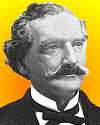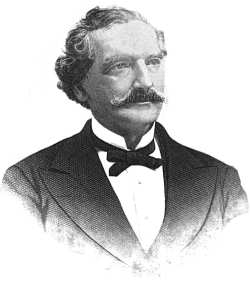 (source)
(source)
|
Gardner Quincy Colton
(7 Feb 1814 - 9 Aug 1898)
American lecturer who was the first to administer nitrous oxide as an anaesthetic. He gave scientific lectures, and his exhibited nitrous oxide gas. Later, he started The Colton Dental Association of New York, where dentists successfully used it as an anaesthetic.
|
In Memoriam
Dr. Gardner Quincy Colton
From Items of Interest (1898)
[This obituary mentions briefly Gardner Quincy Colton's main claim to fame—popularizing nitrous oxide (laughing gas) as a dental anaesthetic and also includes mention of Colton's diverse interests. He exhibited a model railway in 1847, using a metallic track in the circuit to supply electricity to the locomotive's motor. He was also a Shakesperean scholar.]
[p.795] Dr Gardner Quincy Colton, through whose instrumentality “nitrous oxide gas was first used in dentistry, died August 9, 1898, in Rotterdam, Holland. He had been on a visit to Europe and was about to return home when he succumbed to a complication of diseases brought on by old age.
Dr. Colton was born in Georgia, Vt, February 7, 1814, and was the twelfth child of his parents. He first learned chair-making, and when twenty-one years old came to New York, where he followed his trade, studying all the time, however, in the hope of becoming a physician. In 1842 he entered the College of Physicians and Surgeons and later studied in the office of the late Dr. Willard Parker.
Two years after he began to deliver lectures on physiology and chemical phenomena. He had acquired a knowledge of electricity, a science then in its infancy, and invented an electrical motor, which he exhibited, illustrating his lectures with it. This motor is now in the Smithsonian Institute in Washington.
Dr. Colton went to California in 1849, where he searched for gold and practiced medicine among the miners. He was the first man in California to be appointed a Justice of the Peace. With a competence, he returned to the East and went about the country lecturing, telling his audiences of the anaesthetic properties of the laughing gas. In 1863 he established an office in the Cooper Institute. A few years later he was able to visit Paris with a record of 20,000 administrations. Returning to America, he opened offices in Philadelphia, Boston, Baltimore and several other cities, and thus, through his energy and success, the use of nitrous oxide as an anaesthetic became thoroughly established, and dentists throughout the length and breadth of the land began to use it, and it dates from the rediscovery in 1863.
Away back in 1844. when he was lecturing in Hartford, Conn., and showing the effects of nitrous oxide gas on persons to whom he administered it on the stage, Dr. Horace Wells, who became one of his subjects, was impressed with the possibility of using the gas in dentistry. He [p.796] told Dr. Colton of his idea, and the next day he had the gas administered to him and a tooth extracted.
Dr. Colton was also an author and a Shakespearean scholar. He published a brochure on “Shakespeare and the Bible,” and wrote a good deal upon the discovery of anaesthesia.
- Science Quotes by Gardner Quincy Colton.
- 7 Feb - short biography, births, deaths and events on date of Colton's birth.
- Gardner Quincy Colton and Early Electric Railways - article on Colton's early invention, from The Electrical Review (1893).
- Gardner Quincy Colton and Nitrous Oxide - a more detailed article on Colton's work with nitrous oxide, from History of New York City (1884).
- The History of Surgical Anesthesia, by Thomas E Keys. - book suggestion.





